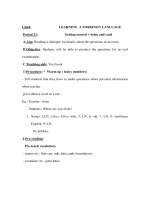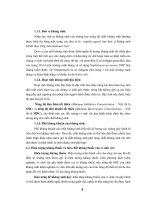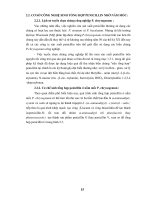GIAO AN UNIT4
Bạn đang xem bản rút gọn của tài liệu. Xem và tải ngay bản đầy đủ của tài liệu tại đây (194 KB, 11 trang )
<span class='text_page_counter'>(1)</span><div class='page_container' data-page=1>
<b>Unit 4: Special Education</b>
<b>Period 19</b>
<b> Lesson: Reading</b>
<b>1. Objective: By the end of the lesson, Ss’ll be able to get the information about a special class.</b>
<b>2. Material: textbook, handouts, posters</b>
<b>3. Procedure</b>
<b>Time</b> <b>Contents</b> <b>Teacher & Ss’</b>
<b>activities</b> <b>Aim</b>
<b>5’</b>
<b>15’</b>
<b>10’</b>
<b>I. WARMER</b>
Look at the Braille Alphabet and work out the message that
<b>follows. (Braille Cell – p.44)</b>
This Braille Cell is used for special education.
<b>II. PRE-READING</b>
<b>1. Pre-teach vocabulary</b>
1. braille (n) : bảng chữ nổi ( picture)
2. disabled (adj) : tàn tật ( picture)
3. dumb (adj) : câm ( explanation)
4. deaf (adj) : điếc ( explanation)
5. mental (adj) : tinh thần trí tuệ
mentally (adj)
6. (to) retard = (to) slow down : làm chậm ( synonym)
mentally retarded : làm chậm sự phát triển trí tuệ
7. demonstration (n) : sự minh hoạ (translation)
8. a finger : ngón tay (realia)
<b>2. Pre-reading Pair work</b>
<b>Look at the activities which do you think would difficult for </b>
<b>blind, deaf and mute children.</b>
<i><b>Activities</b></i> <i><b>Deaf</b></i> <i><b>Dumb</b></i> <i><b>Blind</b></i>
<b>- Listen to teachers</b>
<b>- Pronounce words</b>
<b>- Phone their friends</b>
<b>- Write letters </b>
<b>- Watch TV</b>
<b>- ride bicycle </b>
<b>III. WHILE-READING</b>
<b>Set the scene</b>
<b>We are going to read about a special class of disabled children. </b>
<b>Then, do the exercises.</b>
<i><b>Task 1: </b></i><b>The words in A appear in the reading passage. </b>
<b>Match them with their definitions in B</b>
<b>A</b> <b>B</b>
1. disabled A. taking or needing a lot of time
_ set the Braille
alphabet.
_ get Ss to work out
the message.
_ Ss work in pairs to
work out the
massage.
_ give feedback.
_ elicit new
vocabulary.
_ model 2 times.
_ choral repetition.
_ individual
repetition.
_ check
pronunciation.
_ check stress,
meaning.
_ set the activity.
_ get Ss to work in
pairs.
_ give feedback.
_ set the scene.
Make the
comfortable
atmosphere
for sts to
study
Give sts
some vocab
and structure
to read about
the topic
Want sts to
understand
the passage
</div>
<span class='text_page_counter'>(2)</span><div class='page_container' data-page=2>
<b>7’</b>
<b>8’</b>
<b>1’</b>
2. mentally
retarded
3. time –
consuming
4. demonstration
5. gradually
B. an act of showing or explaining how to
do something
C. unable to use a part of the body in the
normal way
D. slowly , over a long period of time
E. less mentally developed than normal
<b>Key: 1.c 2. E 3. A 4. B 5. D</b>
<b>Task 2 Pair work</b>
<b>Read the passage again and answer the questions</b>
1. How many students are there in Thuy’s class?
2. Why is Thuy’sclass different from other classes?
3. Do students come from poor families?
4. How can she demonstrate for students to read and write in the
math lesson?
<b>Keys: </b>
1. There are 25 students
2. because the students are disabled
3. yes, they do
4. She uses her hands by raising them up and down to demonstrate
for students
<b>IV. POST-READING Individual work</b>
<b>Fill each of the blanks of the summary below with a suitable </b>
<b>word from the reading passage.</b>
Twenty – five (1) <b>disabled</b> children have the chance of learning
how to (2) <b>read </b>and (3) <b>write</b> thanks to the (4) <b>efforts </b>of a young
teacher, Pham Thu Thuy.
Although her idea, at first, met with (5) <b>opposition</b> from the
parents of the disabled children, more children attended her class
later. The teaching work in the special class is (6) <b>time –</b>
<b>comsuming</b>. <b> </b>For example, in a (7) <b>Maths</b> lesson, the teacher has to
use her (8) <b>arms </b>and (9) <b>fingers </b>to teach the children how to add
and subtract. The children are now (10) <b>proud</b> and happy.
<b>V. HOME WORK</b>
- Learn today lesson.
- Do you think the disabled can do the great things? Why or why
not?
_ run through the
task.
_ get Ss to work in
pairs.
_ monitor to help.
_ Ss do the task in
pairs.
_ give feedback.
_ run through the
task.
_ get Ss to work in
pairs.
_ monitor to help.
_ Ss do the task in
pairs.
_ give feedback.
_ introduce Ss the
summary of the
reading.
_ get Ss to work
individually.
_ Ss work
individually.
_ givefeedback.
T gives home work
Students take note
</div>
<span class='text_page_counter'>(3)</span><div class='page_container' data-page=3>
<b>Unit 4: Special Education</b>
<b>Period 20</b>
<b>Lesson: Speaking</b>
<b>1. Objective: By the end of the lesson, Ss’ll be able to ask and answer in an interview about studying.</b>
<b>2. Material: Textbooks, posters, handouts</b>
<b>3. Procedure</b>
<b>Time</b> <b>Contents</b> <b>Teacher & Ss’ activities</b> <b>Aim</b>
<b>5’</b>
<b>10’</b>
<b>I. WARMER</b>
<b> Physics</b>
<b> 15’ test</b>
<b>Maths oral test </b>
<b>II. PRE-SPEAKING</b>
<b> - Set the scene: This is the conversation between an </b>
interview and Hanh – a student about her study.
<b> - Pre-speaking activity: Pair work</b>
The questions in the interview below have been left out. Work
with a partner and fill in the blanks with the right questions.
1. How many subjects did you learn at your school?
2. What was your timetable?
3. What about homework?
4. Which lower-secondary school did you go to?
5. What part of the school life didn’t you like then?
6. Can you tell me about the tests and examinations at your
school then?
<b>Interview: ____ (A) ____________________________?</b>
<b>Hanh : I went to Quoc Thai Lower-secondary School in An</b>
Phu, An Giang
<b>Interview: _______ (B) _________________________?</b>
<b>Hanh : nine. They were Maths, physics, Literature, </b>
Biology, History, Geography, English, Information
Technology and Physics Education.
<b>Interview: _______ (C) _________________________?</b>
<b>Hanh : Well, I went to school in the morning and I often </b>
had five classes.
<b>Interview: ______ (D) ___________________________?</b>
<b>Hanh : Well, we had different kinds of tests, you know. </b>
Oral test, fifteen minutes tests, forty-five minutes tests and the
final examination at the end of the semester.
<b>Interview: _______ (E) __________________________?</b>
<b>Hanh : It’s different with every teacher. Some liked to give </b>
a lot of homework and others did not.
<i><b> Answer keys:</b></i>
<b>_ divide the class into 2 </b>
groups
Instruction: one by one
from each group comes to
the B & adds one word.
The group with more
words is the winner.
_ give feedback
_ set the scene
_ run through 7 questions.
_ get Ss to work in pairs to
fill in the blanks with the
right questions.
_ Ss do the activity in
pairs.
_ give feedback.
Get sts
ready to
learn the
new
lesson
Ask sts
question
s to lead
them in
the
intervie
w
Let sts to
practise
taking
role-play
<b>Subject</b>
</div>
<span class='text_page_counter'>(4)</span><div class='page_container' data-page=4>
<b>20’</b>
<b>10’</b>
<b>1’</b>
<i> A. 4 B. 1 C. 2 D. 6 </i>
<i> E. 3 </i>
<b>III. WHILE-SPEAKING Pair work</b>
Interview your partner and take notes, using the following
questions.
1. What were your subjects then?
2. What was your timetable?
3. What about homework?
4. Which lower-secondary school did you go to?
5. What part of the school life didn’t you like then?
6. Can you tell me about the tests and examinations at your
school then?
7. What did you like best about your school then?
<b>IV. POST-SPEAKING</b>
Tell the whole class what you know about your partner.
Ex: Lan went to Quoc Thai Lower-secondary School. She had
9 subjects to learn at school. She went to school in the morning
and often had 5 classes each morning.
<b>V. HOME WORK</b>
Write a paragraph about what you know about your partner.
_ get Ss to ask and answer
the 7 questions in pairs.
_ Ss carry out an interview
_ monitor to help.
_ get Ss to talk about what
they know about their
partner.
_ Ss talk about their
partner.
_ give feedback.
</div>
<span class='text_page_counter'>(5)</span><div class='page_container' data-page=5>
<b>Unit 4: Special Education</b>
<b>Period 20</b>
<b> Lesson:Listening</b>
<b>1. Objective: By the end of the lesson, Ss’ll be able to know the activities of Vang Trang Khuyet </b>
photography club.
<b>2. Material: Textbooks, posters, handouts</b>
<b>3. Procedure:</b>
<b>Time</b> <b>Contents</b> <b>Teacher & Ss’<sub>activities</sub></b> <b>Aim</b>
<b>5’</b>
<b>8’</b>
<b>7’</b>
<b>I. WARMER Matching</b>
<b>A</b> <b>B</b>
1. photograph a. ăn ảnh
2. photogenic b. người chụp ảnh
3. photographer c. thuật nhiếp ảnh
4. photographic d. thuộc về ảnh
5. photography e. ảnh, bưu ảnh
Keys: 1. e 2. a 3. b 4. d 5. c
<b>II. PRE-LISTENING</b>
<b>1. Pre-teach vocabulary</b>
1. surroundings (n.pl) : môi trường xung quanh
( explanation)
2. sorrow (n) = sadness : nổi đau, nổi buồn
(synonym)
3. passion (n) : sự đam mê
( translation)
4. labour (n) : lao động
( translation)
a labourer : người lao động
5. an exhibition : cuộc triển lãm
( explanation)
6. (to) stimulate :kích thích, đánh thức
(explanation)
<b>2. Pre-activity Pair work</b>
Fill each of the blanks with one word from the box.
I joined a (1) _________ club when was a secondary
school and I have fascinated by (2) _________ ever since.
However, I have decided not to become a professional (3)
________. I once took a (4) ________ of my girl-friend
and she did not took as beautiful in the picture as she was.
I tried to clam her down by saying, “you are not very (5)
_______, honey.”
<b>Keys:</b>
1. Photographic 2. photography
3. Photographer 4. photograph
_ model 5 words
_ get Ss to match in
pairs
_ Ss show their
answers on the
subordinate board.
_ give feedback.
_elicit new
vocabulary.
_ model 2 times.
_ choral repetition.
_ individual
repetition.
_ check
pronunciation.
_ check stress,
meaning.
_ get Ss in pairs to fill
in the blanks.
_ monitor to help.
_ give feedback.
_ model the words
Get sts ready
to learn the
new lesson
Give sts
vocab and
useful
language to
listen the text
</div>
<span class='text_page_counter'>(6)</span><div class='page_container' data-page=6>
<b>10’</b>
<b>10’</b>
<b>10’</b>
5. photogenic
<b>3. Listen and repeat</b>
Surroundings sorrow passion
labourer
Deaf mute exhibition
stimulate
<b>III. WHILE-LISTENING</b>
<b>Set the scene: We going to listen to photography lesson</b>
<b>of disabled children. Then do the listening tasks.</b>
<b>TASK 1. Pair work</b>
<b>Listen to some information about a photography club </b>
<b>and decide whether the statements are true (T) or false</b>
<b>(F).</b>
1. The Vang Trang Khuyet Club’s members are all
disabled children.
2. The club’s members are now teaching photography
to other children.
3. The club’s members are exhibiting their
photographs for the first time in Hanoi.
4. The subject of their photos is the sorrow of being
disabled.
The passion for taking photographs has helped them
escape their sorrow.
<b>Keys:</b>
1T 2F 3T 4F 5T
<i><b>TASK 2. Listen again and answer the questions</b></i>
<i><b>1.</b></i> <i>How old was photographic club?</i>
<i><b>2.</b></i> <i>Who are members in this club?</i>
<i><b>3.</b></i> <i>What were the subjects at the exhibition?</i>
<b>Keys :</b>
<b>1. 6 months </b>
<b>2. They were deaf, mute and mentally retarded </b>
<b>3. They were simple and peaceful</b>
<b>IV. POST-LISTENING </b>
Pair work: summarize the listening text basing on
<b>the cues below:</b>
the name of the club
the members of the club
their lesson?
the lesson help them
<b>V. HOME WORK: </b>
Prepare for writing lesson
Learn the vocab by heart ( in listen and repeat)
twice.
_ choral repetition.
_ set the scene.
_ run through 4
statements.
_ get Ss to listen to
the tape and do the
task.
_ give feedback.
_ get Ss to work in
pairs to listen and fill
in the blanks.
_ give feedback.
_ get Ss answers the
questions in pairs.
_ Ss read out their
answers.
_ set home work.
Sts listen
exactly the
information
</div>
<span class='text_page_counter'>(7)</span><div class='page_container' data-page=7>
<b>Unit 4: Special Education</b>
<b>Period 21</b>
<b> Lesson: Writing</b>
<b>1. Objectives: By the end of the lesson, Ss’ll be able to write a letter of complaint.</b>
<b>2. Materials: Textbooks, posters, handouts</b>
3. Procedure:
<b>Time</b> <b>Contents</b> <b>Teacher and Ss’ activities</b> <b>Aim</b>
<b>5’</b>
<b>7’</b>
<b>I. Oral Test</b>
a. Check the meaning, stress & pronunciation of the
following words “sorrow”, “surrounding”, and “an
exhibition”, “passion.
b. - Tom is a professional_______ in the town.
(photograph)
- He learned about________. ( photograph)
<b>II. Pre-Writing</b>
<b>Task 1 Pair work</b>
Put the following sentences or phrases in the suitable place
in a letter.
A. Dear Sir
B. 53 Ho Xuan Huong steeet HaNoi – VN
C. I’m writing to complain about the poor quality of the
service at your center.
D. 22nd<sub> February , 2008 </sub>
E. The Director
English for today center
731 Van Xuan Street
Ha Noi – VN
F. Do Anh Duc
G. Your faithfully
Address
Greeting
Body
ending
signature
Keys: 1. B 2. E 3. D 4. A 5. C. 6. G 7. F
Task 2 Pair work
<i>After studying for two weeks at English for Today Center, </i>
<i>you notice that everything is worse than what the </i>
<i>advertisement says. A Friend of yours wants to know about</i>
<i>the center and you tell him/her the facts.</i>
Use the following sentences to complete the dialogue
_ call any student to check
the old lesson.
_ give feedback and marks
_ get Ss in pairs to do the
task
_ monitor to help
_ give feedback
_get Ss to work in pairs to
fill in the dialogue.
_ monitor to help.
Make the
comfortable
atmosphere
for sts to
study
Let sts to
know the
structure of
the letter
_______
(1) ______
(2) _____ ____
_____ (3) ____
(4)______
</div>
<span class='text_page_counter'>(8)</span><div class='page_container' data-page=8>
<b>8’</b>
<b>15’</b>
A. I have to pay for them.
B. The room is not air-conditioned, it’s very hot.
C. In fact classes often start late and finish early.
D. I’m not happy with it at all.
E. There are only few native teachers
F. In fact there are more than 30 SS in my class.
A: Are you happy with your study at English for
Today Centre?
B: No, (1) ______________________________
A: Are all the teachers native speakers?
B: No, (2) ______________________________
A: The advertisement says there are no more than 20
students in a class. Is that true?
B: No, (3) ______________________________
A: Do you get free books and cassette tapes?
B: No, (4) ______________________________
A: What about the classrooms? Are they
air-conditioned?
B: No, (5) ______________________________
A: What don’t you like most about the centre?
B: It’s the time. They say the class time is from 5:30
p.m. to 8:30 p.m. but (6) __________.
A: Well, everything is different from what the
advertisement says. What are you going to do?
B: I am going to write a letter of complaint to the
director of the centre.
<b>Keys:</b>
<b>1. D 2. E 3.F 4. A 5.B 6.C</b>
<b>A letter of complaint includes three main parts: </b>
<b>- Opening</b>
<b>- Explaining the problem</b>
<b>- Suggesting a resolution</b>
<b>III. While- Writing</b>
<i>Using the information from the dialogue in Task 1, </i>
<i>complete the letter of complaint below:</i>
53 Ho Xuan Huong Street
Hanoi – Vietnam
The Director
English for Today Centre
731 Van Xuan Street
Hanoi – Vietnam
22nd<sub> February, 2006</sub>
Dear Sir,
I am writing to complain about the poor quality of the service
at your centre. Everything seems to be worse than what you
say in the advertisement.
……….
……….
To resolve the problem, I require you to give me a refund.
Enclosed is a copy of the receipt.
_ give feedback.
_ set the content of
complaint letter.
_ get Ss to work in pairs to
write the letter.
</div>
<span class='text_page_counter'>(9)</span><div class='page_container' data-page=9>
<b>10’</b>
<b>1’</b>
I look forward to hearing from you and to getting a quick
resolution of this problem. Please contact me at the above
address or by phone at (04) 7.222999.
Yours faithfully,
Do An Duc
<b>IV. Post-Writing</b>
<i>Ask SS exchange their writing with a friend; pick up some </i>
<i>writings to check the mistakes as the whole class.</i>
<i><b>Keys:</b></i>
………
First of all, you say that there are only native teachers, but
my class has one Vietnamese teacher. You also say that
each class has no more than 20 SS but there are over 30 SS
in my class. Furthermore, in the ad., you say that we can
have books and cassette tapes free of charge but in fact we
had to pay for them. Next, the room is not air-conditioned.
Finally, the class time is not the same as what the ad. Says.
Classes not only start late but also finish early.
………
<b>V. Home Work </b>
Complete and rewrite your writing into notebook
_ Ss exchange their writing.
_ pick up some of the Ss’
writing to give feedback.
_ set home work.
<b>Unit 4: Special Education</b>
<b>Period 21</b>
<b> Lesson: Language focus</b>
<b>1. Objective: By the end of the lesson, Ss’ll be able to pronounce / / & / / correctly, know how to use </b>
‘the + Adj” to show a group of people, use ‘used to + V” correctly.
<b>2. Materials: Textbooks, posters, handouts.</b>
<b>3. Procedure</b>
<b>Time</b> <b>Contents</b> <b>Teacher & Ss’</b>
<b>activities</b>
<b>Aim</b>
<b>5’</b>
<b>7’</b>
<b>I. Oral Test</b>
a. What are the parts of a letter?
Address, greeting, body, ending, signature
b. What are the contents of a complaint letter?
Opening, explaining the problem, suggesting a resolution
c. sentence building
I/ writing / complain / the bad service / your hotel.
I’m writing to complain about the bad service of your
hotel.
<b>II. Presentation</b>
<b>1. Pronunciation</b>
<i>Ask SS to listen and distinguish:</i>
<b> A B</b>
<b> / /: a short sound / /: a long sound</b>
top wrong boss call walking more
job doctor box sport four talk
<i><b>Practice these sentences.</b></i>
1. Put the socks on top of the box.
2. He lost his job as a doctor in the hospital.
_ call any student to
check the old lesson.
_ give feedback and
marks.
_ present the two
sounds.
_ Ss listen and repeat.
_ model the six
sentences.
_ Ss practice in pairs.
_ monitor to help Ss.
Get sts
ready to
learn the
new lesson
</div>
<span class='text_page_counter'>(10)</span><div class='page_container' data-page=10>
<b>8’</b>
<b>7’</b>
<b>8’</b>
3. What’s wrong with you, boss?
4. Is walking called a sport?
5. He can’t talk to her any more.
6. Four of us have walked for fourteen miles.
<i><b>2. Grammar and Vocabulary</b></i>
<i>Ex: The blind in my neighbor used to make </i>
toothpicks, which gave them happiness.
<i><b>The + adjective</b></i>
The blind = blind people
<b>Some common expressions: the dead, the old, the poor, </b>
the rich, the jobless, the young, the handicapped, the
mentally retarded, the unemployed, the injured…
<b> : The + adj used to describe a group of people as a Use</b>
whole: e.g. the rich, the poor.
<i><b>Used to + Infinitive</b></i>
<b> : Used to + infinitive used to express a past action Use</b>
that doesn’t happen at the present.
<i><b>Which</b></i>
<b> : This can be used in relative clause to refer to the Use</b>
<i>whole of the earlier clause.</i>
<b>III. Practice</b>
<i><b>Exercise 1. Pair work</b></i>
<i>Complete these sentences using the + one of the adjectives:</i>
injured <i><b>poor</b></i> <i><b>rich</b></i> <i><b>sick</b></i>
<i><b>unemployed young</b></i>
1. <i>The young have the future in her hands.</i>
2. Ambulances arrived at the scene of the accident and
took __________ to hospital.
3. Life is all right if you have a job, but things are not
so easy for __________.
4. Julia has been a nurse all her life. She has spent her
life caring for __________.
5. In England there is an old story about a man called
Robin Hood. It is said that he robbed __________
and gave the money to __________.
<b>Keys:</b>
2. the injured
3. the unemployed
4. the sick
5. the rich
<i><b>Exercise 2. Pair work</b></i>
<i> Complete the sentences with used to … + a suitable verb. </i>
<b>1.</b> Dennis gave up smoking two years ago. He used to
<i><b>smoke 40 cigarettes a day.</b></i>
<b>2.</b> Liz __________ a motorbike, but last year she sold
it and bought a car.
<b>3.</b> We came to live in Manchester a few years ago. We
__________ in Nottingham.
<b>4.</b> I rarely eat ice cream now, but I __________ it
_ elicit the situation
from Ss and then
highlight the structures
in the example.
_ introduce the use of
grammatical points.
_ Ss listen and copy the
target language.
_ ask Ss to do ex 1 in
pair.
_ Ss work in pair and
read out their answers.
_ give feedback.
way in
pronunciati
on
Supply the
grammar
points for
sts
</div>
<span class='text_page_counter'>(11)</span><div class='page_container' data-page=11>
<b>10’</b>
when I was a child.
<b>5.</b> Jim __________ my best friend, but we aren’t
friends any longer.
<b>6.</b> It only takes me about 40 minutes to get to work
since the new road was opened. It __________
more than an hour.
<b>7.</b> There __________ a hotel opposite the station, but
it closed a long time ago.
<b>8.</b> When you lived in London, __________ to the
theatre?
<b>Keys:</b>
2. used to have 3. used to live 4. used to eat
5. used to be 6. used to take 7. used to be
8. did you use to go
<i><b>Exercise 3. Join a sentence from A with one from B to </b></i>
<i>make a new sentence. Use which.</i>
<i><b>2. Jill isn’t on the phone.</b></i> <i><b>B. This means we can’t go </b></i>
away tomorrow.
<i><b>3. Neil has passed his </b></i>
exam.
C. This makes it difficult to
contact her.
<i><b>4. Our flight was delayed.</b></i> D. This make difficult to
sleep.
<i><b>5. Ann offered to let me </b></i>
stay in her house. E. This was very nice of her.
<i><b>6. The street I live in is </b></i>
very noisy at night.
F. This is good news.
<i><b>7. Our car has broken </b></i>
down. <i><b>G. This meant we had to </b></i>wait for hours at the
airport.
<b>Keys</b>
2. Jill isn’t on the phone, which makes it difficult to contact
her
3. Neil has passed his exam, which is good news.
4. Our flight was delayed, which meant we had to wait for
hours at the airport.
5. Ann offered to let me stay in her house, which was very
nice of her.
6. The street I live in is very noisy at night, which makes
difficult to sleep.
7. Our car has broken down, which means we can’t go
away tomorrow.
<b>V. Home Work </b>
_ ask Ss to do ex 2 in
pair.
_ Ss work in pair and
read out their answers.
_ give feedback.
_ get SS to do ex 3 in
pair.
_ Ss work in pair to do
ex 3 and then come to
BB to write their
answer.
_ give feedback.
</div>
<!--links-->









